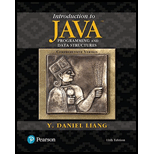
Concept explainers
(Math: The Complex class) A complex number is a number in the form a + bi, where a and b are real numbers and i is
a + bi + c + di = (a + c) + (b + d)i
a + bi – (c + di) = (a – c) + (b – d)i
(a + bi) * (c + di) = (ac — bd) + (bc + ad)i
(a + bi) / (c + di) = (ac + bd) / (c2 + d2) + (bc – ad)i / (c2 + d2)
You can also obtain the absolute value for a complex number using the following formula:
(A complex number can be interpreted as a point on a plane by identifying the (a, b) values as the coordinates of the point. The absolute value of the complex number corresponds to the distance of the point to the origin, as shown in Figure 13.10.)
Design a class named Complex for representing complex numbers and the methods add, subtract, multiply, divide, and abs for performing complex-number operations, and override toString method for returning a string representation for a complex number. The toString method returns (a + bi) as a string. If b is 0, it simply returns a. Your Complex class should also implement Cloneable and Comparable. Compare two complex numbers using their absolute values.
Provide three constructors Complex (a, b), Complex (a), and Complex (). Complex () creates a Complex object for number 0, and Complex (a) creates a Complex object with 0 for b. Also provide the getRealPart() and getImaginaryPart () methods for returning the real part and the imaginary part of the complex number, respectively.
Draw the UML class diagram and implement the class. Write a test program that prompts the user to enter two complex numbers and displays the result of their addition, subtraction, multiplication, division, and absolute value. Here is a sample run:
| Enter the first complex number: 3.5 5.5 Enter the second complex number: –3.5 1 (3.5 + 5.5i) + (–3.5 + 1.0i) = 0.0 + 6.5i (3.5 + 5.5i) – (–3.5 + 1.0i) = 7.0 + 4.5i (3.5 + 5.5i) * (–3.5 + 1.0i) = –17.75 + –15.75i (3.5 + 5.5i) / (–3.5 + 1.0i) = –0.5094 + –1.7i |(3.5 + 5.5i)| = 6.519202405202649 |
Want to see the full answer?
Check out a sample textbook solution
Chapter 13 Solutions
Introduction to Java Programming and Data Structures, Comprehensive Version (11th Edition)
- Draw an ERD that will involve the entity types: Professor, Student, Department and Course. Be sure to add relationship types, key attributes, attributes and multiplicity on the ERD.arrow_forwardDraw an ERD that represents a book in a library system. Be sure to add relationship types, key attributes, attributes and multiplicity on the ERD.arrow_forward2:21 m Ο 21% AlmaNet WE ARE HIRING Experienced Freshers Salesforce Platform Developer APPLY NOW SEND YOUR CV: Email: hr.almanet@gmail.com Contact: +91 6264643660 Visit: www.almanet.in Locations: India, USA, UK, Vietnam (Remote & Hybrid Options Available)arrow_forward
- Provide a detailed explanation of the architecture on the diagramarrow_forwardhello please explain the architecture in the diagram below. thanks youarrow_forwardComplete the JavaScript function addPixels () to calculate the sum of pixelAmount and the given element's cssProperty value, and return the new "px" value. Ex: If helloElem's width is 150px, then calling addPixels (hello Elem, "width", 50) should return 150px + 50px = "200px". SHOW EXPECTED HTML JavaScript 1 function addPixels (element, cssProperty, pixelAmount) { 2 3 /* Your solution goes here *1 4 } 5 6 const helloElem = document.querySelector("# helloMessage"); 7 const newVal = addPixels (helloElem, "width", 50); 8 helloElem.style.setProperty("width", newVal); [arrow_forward
- Solve in MATLABarrow_forwardHello please look at the attached picture. I need an detailed explanation of the architecturearrow_forwardInformation Security Risk and Vulnerability Assessment 1- Which TCP/IP protocol is used to convert the IP address to the Mac address? Explain 2-What popular switch feature allows you to create communication boundaries between systems connected to the switch3- what types of vulnerability directly related to the programmer of the software?4- Who ensures the entity implements appropriate security controls to protect an asset? Please do not use AI and add refrencearrow_forward
 Microsoft Visual C#Computer ScienceISBN:9781337102100Author:Joyce, Farrell.Publisher:Cengage Learning,
Microsoft Visual C#Computer ScienceISBN:9781337102100Author:Joyce, Farrell.Publisher:Cengage Learning, C++ Programming: From Problem Analysis to Program...Computer ScienceISBN:9781337102087Author:D. S. MalikPublisher:Cengage Learning
C++ Programming: From Problem Analysis to Program...Computer ScienceISBN:9781337102087Author:D. S. MalikPublisher:Cengage Learning C++ for Engineers and ScientistsComputer ScienceISBN:9781133187844Author:Bronson, Gary J.Publisher:Course Technology Ptr
C++ for Engineers and ScientistsComputer ScienceISBN:9781133187844Author:Bronson, Gary J.Publisher:Course Technology Ptr Programming with Microsoft Visual Basic 2017Computer ScienceISBN:9781337102124Author:Diane ZakPublisher:Cengage LearningProgramming Logic & Design ComprehensiveComputer ScienceISBN:9781337669405Author:FARRELLPublisher:Cengage
Programming with Microsoft Visual Basic 2017Computer ScienceISBN:9781337102124Author:Diane ZakPublisher:Cengage LearningProgramming Logic & Design ComprehensiveComputer ScienceISBN:9781337669405Author:FARRELLPublisher:Cengage EBK JAVA PROGRAMMINGComputer ScienceISBN:9781337671385Author:FARRELLPublisher:CENGAGE LEARNING - CONSIGNMENT
EBK JAVA PROGRAMMINGComputer ScienceISBN:9781337671385Author:FARRELLPublisher:CENGAGE LEARNING - CONSIGNMENT







